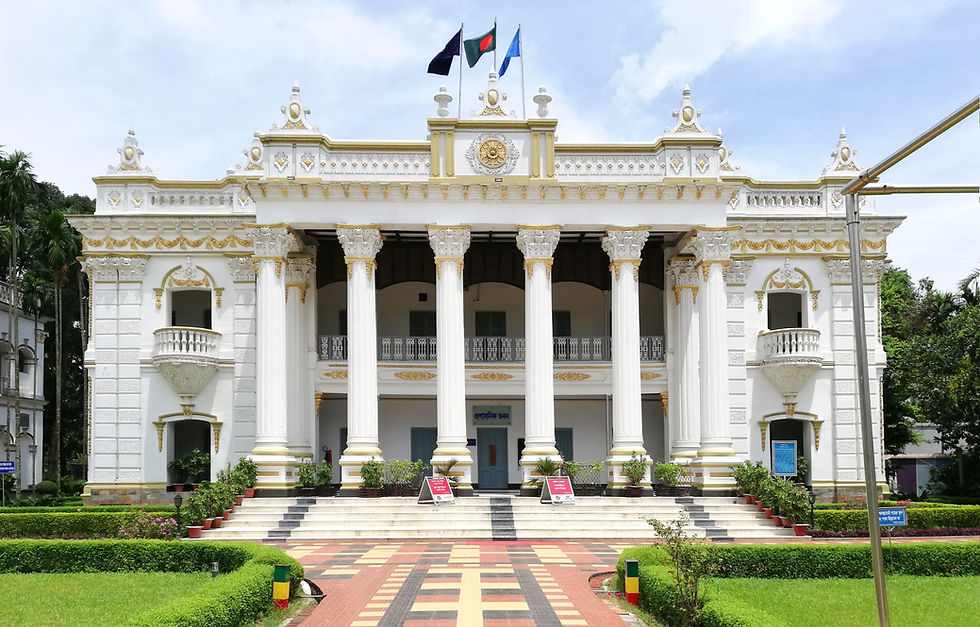Ahsan Manzil: The Pink Palace of Dhaka
- Niharika Momtaz Production

- Aug 21, 2024
- 3 min read
Updated: Sep 14, 2024

Ahsan Manzil, often called the 'Pink Palace', is a renowned historical site in Dhaka, Bangladesh. This magnificent palace lies on the banks of the Buriganga River, reflecting the rich history, architectural beauty, and cultural heritage of this great city. Ahsan Manzil is not merely a building; it symbolizes Nawabs' heritage in Dhaka and shows how glorious it was.
A Brief History of Ahsan Manzil
Ahsan Manzil dates back to the 19th century when British colonial rule turned Dhaka into a thriving center of trade and administration. In 1872, it was originally constructed by Nawab Abdul Ghani, a significant personality in Dhaka's historical context. Known after his son Khwaja Ahsanullah, it served as an official residence for the Nawab family, notable feudal chiefs and actors in Bengal's politics and social life.
More than just a home, it was a place where crucial political meetings, cultural ceremonies, and social functions took place. Its influence extended beyond its location, shaping the history of the region. Over time, numerous significant events occurred at this location, including the culmination of the independence movement that led to the creation of the Bangladeshi nation.
Architectural Marvel
A remarkable blend of European style and Indo-Saracenic architecture makes Ahsan Manzhil famous for its stunning architecture. The exterior wall, which earned itself the nickname "The Pink Palace," is an outstanding feature among others in this palace. Its construction represents the Mughal-Gothic mix applied by Indians during their last days under British colonialism.
This palace consists of two main sections: east and west wings linked by a central dome. Ahsan Manzil's most recognized feature is the central dome, which rises high over the palace and serves as its focal point. The outside of the building features intricate detailing, such as beautiful arches, decorative cornices, and finely sculpted columns that exhibit the culture of this period.
Ahsan Manzil is no less majestic inside. It has numerous rooms filled with authentic furniture from different periods, including chandeliers and decorative arts. The grand staircase leading to the main entrance is a masterpiece in itself, suggesting luxury and splendor on its own merits. The interiors of this palace display what the Nawabs' luxurious lifestyle was like, apart from giving an indication of cultural richness at that time.
A Museum of History
Today, Ahsan Manzil acts as a museum preserving Dhaka's history for generations to come. This museum has many exhibitions, including ancient pictures, artifacts, and personal items from the Nawab Family. These exhibits provide insight into the daily life of one of Dhaka's influential families, including their political and cultural impacts as well as their personal stories.
The center serves as an educational facility and promotes cultural interaction. Dhaka's history is rich; hence, thousands of scholars, college students, and travelers visit Ahsan Manzil yearly to learn about this fact and see the beautiful Pink Palace. The center also has a mandate of protecting cultural heritage in Bangladesh and making its own people feel proud.
Cultural and Social Significance
Ahsan Manzil's cultural and social significance is immeasurable for the people of Dhaka and all Bangladeshis. The palace does not just represent the past; it symbolizes the traditions that make up the city's image. Recently, it became a meeting point for individuals with diverse cultural values. This transition from a private residence into a public museum illustrates how modernity has transformed our understanding of heritage.
Ahsan Manzil's influence transcends its walls. Literature, art, and movies often refer to this building so that the whole country will remember it forever. It reminds everyone about the gloriousness and splendor that existed once upon a time and stresses the necessity of saving such historical sites for descendants.
Preservation and Legacy
It is crucial to protect Ahsan Manzil because this means not only preserving architecture but also commemorating one significant stage in Dhaka's history. Over time, several restorations have been done so that it doesn't get damaged by aging or environmental issues. These developments are necessary to ensure that Ahsan Manzil remains an active part of the Dhaka cityscape.
In conclusion, however, it should be noted that apart from being just a historical monument, Ahsan Manzil represents a wealth of architectural genius as well as deep-rooted culture in Dhaka city idealism epitomized by Pink Palace that still leaves us awestruck today, prompting introspection regarding our immediate surroundings as well as what we stand for as a people. Every trip to Dhaka would be complete with a visit to Ahsan Manzil, which provides a glimpse into the grandeur of an era gone by and the lasting legacy left by the Nawabs of Dhaka.




Comments